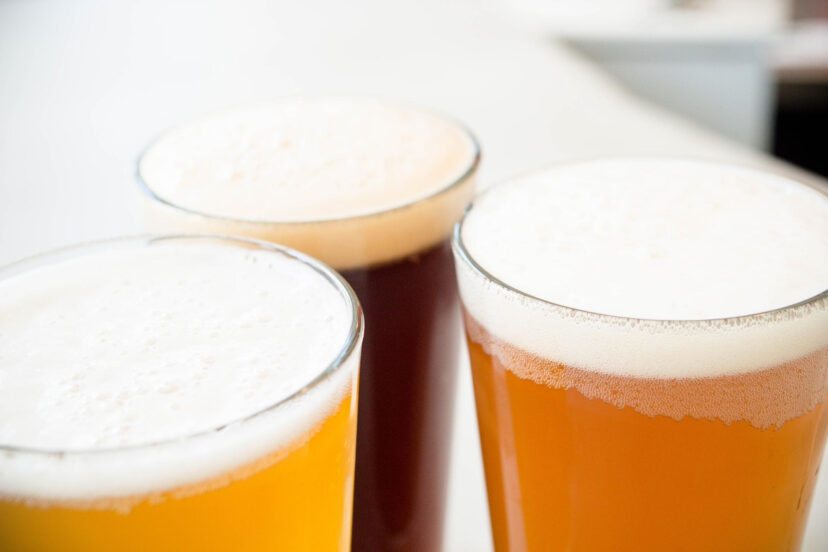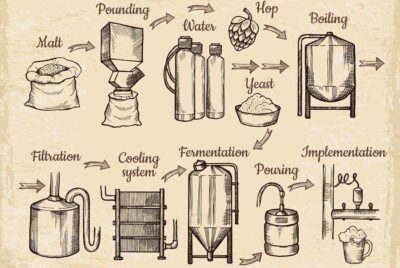IPAs
Have you ever wondered why IPAs have become the darling of the craft beer world? These bold, hop-forward brews have captured the hearts of beer enthusiasts everywhere, and their story is as fascinating as their flavor. From their humble beginnings as a practical solution to a colonial-era problem to their current status as craft beer royalty, IPAs (India Pale Ales) have undergone an incredible transformation that’s worth raising a glass to.
The Birth of a Legend: How IPAs Came to Be
Picture this: it’s the late 18th century, and British brewers are scratching their heads, trying to figure out how to keep their precious ales from spoiling during the long voyage to India. The solution they discovered would revolutionize the brewing world forever. By increasing both the hop content and alcohol strength, these innovative brewers created what we now know as India Pale Ales, or IPAs.
Leading the charge was Hodgson’s Bow Brewery, whose experiments with heavily hopped ales set the stage for the IPA revolution. These early IPAs weren’t just beers; they were liquid proof that necessity truly is the mother of invention. The extra hops and alcohol acted as natural preservatives, ensuring that British troops stationed in India could enjoy a taste of home, even after months at sea.
The Evolution of IPAs: A Style That Refuses to Stand Still
Today’s IPA landscape is vastly different from those original British exports. Like a family tree with many branches, IPAs have evolved into a diverse array of styles, each with its own distinct personality. The traditional English IPA, with its perfect balance of malty sweetness and hop bitterness, laid the groundwork for what was to come.
Then came the American craft beer revolution, and with it, the American IPA. Bold, brash, and unapologetically hoppy, these newcomers showcased the citrusy, piney characteristics of American hop varieties. West Coast IPAs pushed the envelope even further, becoming legendary for their intense bitterness and aromatic complexity.
But perhaps the most revolutionary development in recent years has been the New England IPA (NEIPA). These hazy, juice-bomb IPAs turned the beer world on its head with their smooth, tropical fruit flavors and minimal bitterness. They proved that IPAs could be approachable and complex at the same time, winning over even the most hop-hesitant drinkers.
The Art and Science of Brewing IPAs
Creating the perfect IPA is a delicate dance between art and science. At the heart of every great IPA is the careful selection and use of hops. These magical green cones contribute not just bitterness, but an incredible array of flavors and aromas that can range from grapefruit and pine to passion fruit and mango.
Modern brewers have become hop artists, painting with an ever-expanding palette of varieties. They experiment with hop timing, using techniques like dry-hopping and hop bursting to extract maximum flavor with minimal bitterness. The result is a new generation of IPAs that showcase the incredible diversity of hop characteristics.
But hops aren’t the only stars of the show. The choice of malt creates the backbone of the beer, providing balance and body. Yeast strains contribute their own unique flavors and can dramatically affect how we perceive hop character. Even water chemistry plays a crucial role, with many brewers adjusting their water profiles to enhance specific hop characteristics.
The IPA Revolution: More Than Just a Beer Trend
The rise of IPAs has been nothing short of revolutionary. What started as a practical solution for long-distance shipping has become the flagship style of the craft beer movement. IPAs have pushed boundaries, challenged conventions, and inspired countless brewers to think outside the box.
This revolution has had ripple effects throughout the beer industry. The demand for new hop varieties has led to innovative farming practices and the development of exciting new hop strains. Smaller breweries have found success by specializing in IPAs, while established breweries have had to adapt to changing consumer preferences.
Building Community Through IPAs
One of the most beautiful aspects of the IPA phenomenon is how it brings people together. Beer festivals featuring special IPA releases draw thousands of enthusiasts who line up for hours to try the latest creations. Online communities share tasting notes and trading tips, while local tap rooms become gathering places for hop heads to compare favorites and discover new brews.
This sense of community extends to the brewing industry itself. Collaboration brews between different breweries have become common, with brewers sharing knowledge, techniques, and sometimes even their precious hop contracts to create unique IPA expressions.
The Perfect Pour: How to Enjoy Your IPA
To fully appreciate an IPA, proper serving is essential. Temperature matters – too cold and you’ll miss out on the complex hop aromas and flavors. Most experts recommend serving IPAs between 45-50°F (7-10°C). The right glassware can also enhance your experience, with IPA-specific glasses designed to capture and concentrate hop aromatics.
When it comes to food pairing, IPAs are surprisingly versatile. Their bold flavors can stand up to spicy dishes, while their bitterness cuts through rich, fatty foods. Try pairing a citrusy IPA with Thai curry, or a dank, piney West Coast IPA with a blue cheese burger. The possibilities are endless.
Sustainability and the Future of IPAs
As the craft beer industry grows, so does its environmental awareness. Many breweries are leading the charge in sustainable practices, from using solar power to implementing water conservation measures. Some are even experimenting with new hop products that require less farming space and shipping weight.
Looking ahead, the future of IPAs seems limitless. Brewers continue to push boundaries with new techniques and ingredients. Low-alcohol IPAs provide full hop flavor with less punch, while emerging hop varieties promise new flavor experiences we haven’t even imagined yet.
Health Considerations and Responsible Enjoyment
While IPAs can be part of a balanced lifestyle, it’s important to enjoy them responsibly. The higher alcohol content of many IPAs means moderation is key. On the positive side, hops contain compounds with potential health benefits, including antioxidants and compounds that may help with sleep and anxiety.
Addressing the Controversies
Not everyone loves IPAs, and that’s okay. Critics sometimes argue that the style has become too dominant or that brewers focus too much on extreme bitterness. However, the evolution of IPAs shows that the style can accommodate many preferences, from subtle and balanced to bold and intense.
Conclusion: The Ongoing IPA Journey
The story of IPAs is far from over. From their historical origins to their current status as craft beer icons, these beloved brews continue to evolve and inspire. Whether you’re a dedicated hop head or just starting to explore the world of craft beer, there’s an IPA out there for you.
As we look to the future, one thing is certain: IPAs will continue to surprise and delight us. Their journey from practical solution to cultural phenomenon shows no signs of slowing down. So the next time you raise a glass of your favourite IPA, remember you’re not just drinking a beer – you’re participating in a continuing revolution in craft brewing.
Essential IPA FAQ
Q: Why are IPAs so popular?
A: IPAs offer incredible flavor diversity, from bright and fruity to deep and piney, appealing to many different palates. Their popularity has also been driven by craft beer culture and continuous innovation in brewing techniques.
Q: How long do IPAs stay fresh?
A: Most IPAs are best consumed within 3-4 months of packaging. Unlike some styles, IPAs generally don’t benefit from aging, as hop flavors and aromas fade over time.
Q: What makes a New England IPA different from other IPAs?
A: NEIPAs are characterized by their hazy appearance, smooth mouthfeel, and intense tropical fruit flavors with minimal bitterness. They achieve this through specific brewing techniques and heavy dry-hopping.
Q: Are there any lower-alcohol IPAs available?
A: Yes! Session IPAs offer full hop flavor with lower alcohol content (usually around 4-5% ABV), making them perfect for extended enjoyment.
Q: How can I start appreciating IPAs if I find them too bitter?
A: Start with newer styles like New England IPAs or session IPAs, which tend to be less bitter and more fruit-forward. Gradually explore different styles as your palate adapts.
Remember, the world of IPAs is vast and varied. Don’t be afraid to experiment and find the styles that speak to your taste buds. After all, every IPA enthusiast started somewhere on their journey of discovery.




